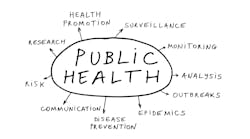Researchers and advocates who track healthcare in prisons forewarned that COVID-19 was going to bring disaster to incarcerated people, prison staff and surrounding communities. The well-documented inadequate response has proven them correct. Will anything change going forward?
With 148,938 COVID-19 cases and 1,228 COVID-related deaths among people incarcerated in U.S. prisons, the COVID Prison Project (CPP) was established to increase transparency about coronavirus in incarceration settings as well as to track national and state policies and procedures. Advocates point out that in jails and prisons, inmates have little freedom of movement, often lack access to adequate hygiene and healthcare facilities, and may be unable to isolate if infected.
The CPP’s co-founder, Lauren Brinkley-Rubinstein, Ph.D., assistant professor of social medicine at UNC-Chapel Hill, researches how incarceration can impact health outcomes. She joined a recent panel discussion of how COVID-19 has spread through jails and prisons, how that is affecting not only inmates but also surrounding communities, what corrections officials are—and are not—doing to address COVID-19, and what should be done to improve health outcomes for and control the spread of COVID-19 among this population.
“We knew this was going to hit hard in jails and prisons,” she said. “By the summer it was clear there had been major outbreaks. Nine of the largest outbreaks in the country were in prisons and jails. We have seen some increases in testing, but it has never been adequate. There has been some one-time testing in prisons to appease advocates, but we still haven’t seen any long-term testing plans by a majority of places.”
“Prisons started giving us more data than they ever had before,” Brinkley-Rubinstein said. “We now have a pretty good understanding of incidents in 53 prison systems and 70 jails that are giving us the number of cases, deaths, and people tested. Our group is doing preliminary analysis of policies to make the link between correctional health and public health.” Only three states so far are providing any demographic data on COVID in prison, and she said her team of researchers knows much less about what is happening in jails, she noted. “Even the biggest jails aren’t giving us much data at all.”
‘Like having a cruise ship in every county’
Joining Brinkley-Rubinstein in speaking at the forum co-hosted by the Duke Initiative for Science & Society was Joseph Neff, a staff writer for The Marshall Project, an online news site covering the legal system and immigration. He expressed concern about jails as nexuses of community spread. Most people in jail are only there for a few weeks or months, he noted. “It’s like having a cruise ship in every county with people cycling in and out and lots of community spread. I am frustrated that this is an untold story happening all over the country. There is one county jail in Georgia that had 100 cases this week, 30 involving staff.” These outbreaks are popping up and are often unreported in the media, he said.
Neff added that prisons have been slow to test both incarcerated people and staff members. Part of the reason wardens may not want to test staff is that they are so understaffed already. “When prisons did mass testing, they found mass infection. Prison wardens have been slow to test because they don’t to know what is going on in their facilities,” he said. It makes sense when you consider the crisis of short staffing in prisons. “In North Carolina state prisons are 25 to 30 percent understaffed. In Mississippi, only 50 percent of positions are filled. I believe they don’t want to know how infected the staff is because they don’t want to scare any more employees away. That is a managerial challenge to them.”
One way to deal with the situation would be to send more incarcerated people home early, Neff noted. Many are on work release and are trusted to go out into the community every day but return to the prison to sleep at night. “There is a real resistance to letting people out,” Neff said. He cited the following numbers for the first three months of pandemic — March, April, and May — concerning prisoners who applied for compassionate relief because they are old and/or sick and don’t have much time left on their sentences. In those three months, 10,940 applied. Of those, wardens approved 156, less than 1.5 percent. The rest were denied or ignored. Of the 156 approved, 84 were submitted to the federal Bureau of Prisons, which denied 73 of the 84. So it approved 11 of 11,000 who applied, Neff said.
‘Atrocious conditions’
Maria Morris, J.D.; senior staff attorney for the National Prison Project at the ACLU, also spoke at the event. She said that one of the things that tends to happen when a natural disaster or any other kind of disaster arises is that prisons and jails are forgotten about. “We began sounding the alarm early on to think through how prisons and jails dealt with the illness, because there are so many factors about the way they function that made it almost a certainty that what has happened would happen,” Morris said. “We knew that once in, COVID-19 would tear through prisons doing terrible harm. As the months wore on, we have been litigating with some but not great success for the most part. Appellate courts have not been very receptive to these cases.”
“What we have seen have been atrocious conditions,” Morris added. “Separate from COVID, prisons have problems of being crowded and not having very good medical care, and high populations of people that have the vulnerabilities that are likely to result in serious cases of COVID and death — high levels of diabetes, hypertension and lung diseases. In addition, they don’t tend to be the cleanest of places,” she explained, adding that even in places where there is a policy of wearing masks, staff and incarcerated people are not wearing masks consistently, and they tend to have poor quality masks. “What is being reported is the number of positive tests. They are not doing a good job of quarantining or isolating patients and when they are isolated, it is in solitary confinement, which carries its own risks.”
She gave one example from North Carolina in June. Its low-security facility in Butner prison had a significant outbreak and several people died. On June 1, they decided to do a round of mass testing. “Unfortunately, they didn’t do anything with the test results until June 10. The case numbers were jumping by 200 per day and had reached 600 in that facility out of 1,100 total inmates. They divided them up into housing units by whether they had tested positive or negative 10 days earlier, even though they were all in close contact that whole time. People were placed in negative units, even though they now had symptoms. So the testing didn’t have impact it could have if they had acted upon it in a timely way.”
Brinkley-Rubinstein add that lag times in lab results and an inability to do contact tracing and quarantining — issues that haven’t been mastered in community at large— are so much worse in these settings. In response to an audience question, she said that how vaccines will be distributed in prisons and jails is another issue that will need to be addressed from an ethical framework and with the input of incarcerated people.
By midsummer, it becoming clear that very few judges had an appetite for a broad release of people from prisons and even jails, Morris said. “There was some movement with jails trying to bring populations down somewhat by limiting people they were bringing in. As the attention started waning, you would see jail populations ticking back up. The focus has been more on trying to improve conditions. But they needed to address the risk and they weren’t doing that. We are still pushing forward with litigation to keep the pressure up. We are trying to keep scrutiny from the public and courts on prisons and jails.”


